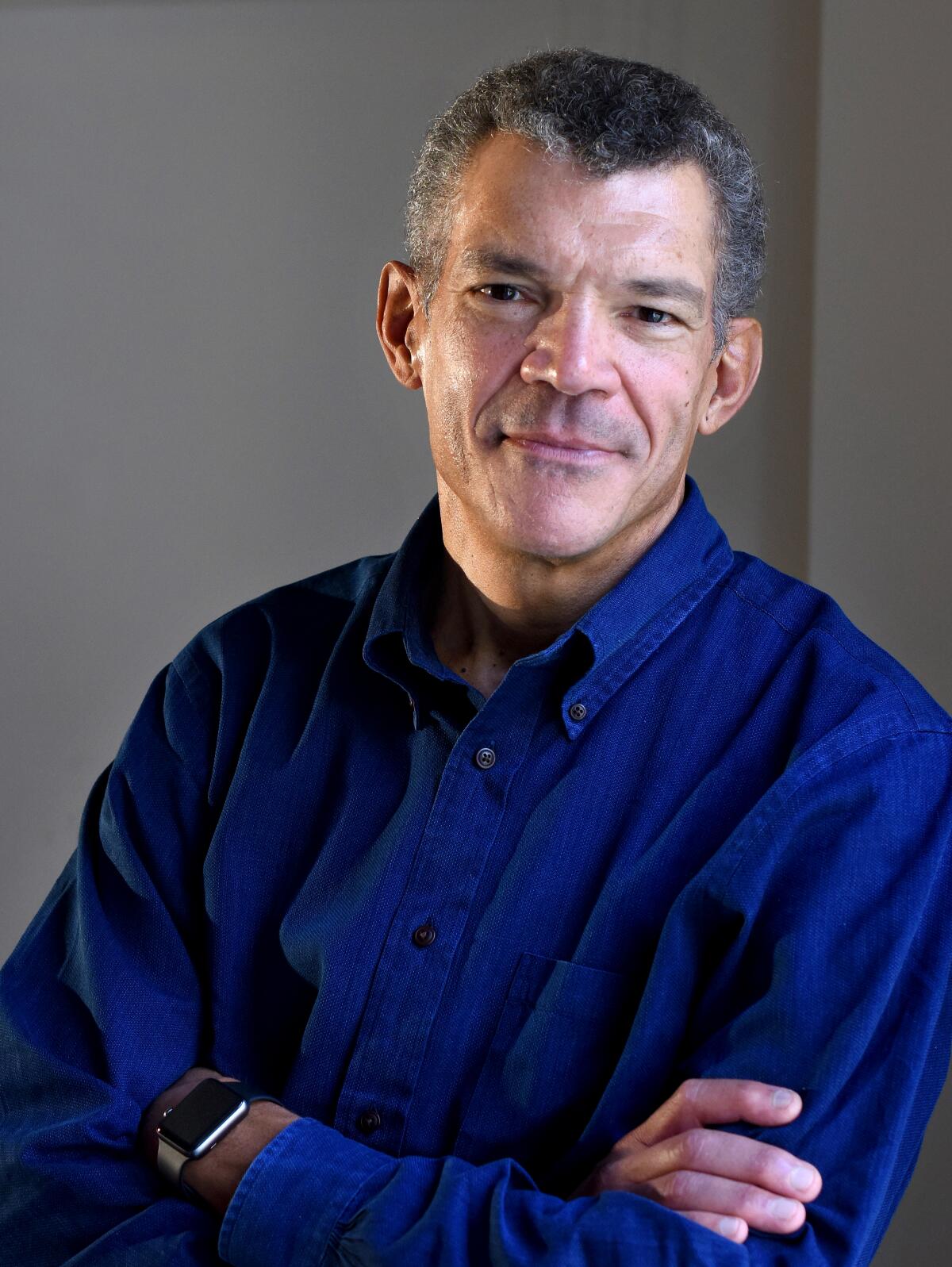What would Malcolm X say about Trump? New book argues his legacy is more important than ever

- Share via
Book Review
The Afterlife of Malcolm X: An Outcast Turned Icon's Enduring Impact on America
By Mark Whitaker
Simon & Schuster: 448 pages, $31
If you buy books linked on our site, The Times may earn a commission from Bookshop.org, whose fees support independent bookstores.
If you were around in the early ’90s you saw a whole lot of baseball caps emblazoned with a simple capital “X.” They marked an ingenious marketing stroke on the part of filmmaker Spike Lee, who would soon unveil one of his best movies, 1992’s “Malcolm X,” starring Denzel Washington as the fiery, prophetic and often misinterpreted Black nationalist leader. The film and the discussion and debate it inspired marked a new surge in Malcolm Fever that included but went far beyond fashionable headwear.
But Malcolm X, who was assassinated in 1965 shortly after breaking with the Nation of Islam, never really went out of style. This is the argument that drives “The Afterlife of Malcolm X,” Mark Whitaker’s incisive survey of Malcolm’s enduring place in American culture, and the slow-grinding process of discovering who really killed him (and who didn’t). “Afterlife” really tells two stories, running along parallel tracks: One is a work of cultural history that touches on Malcolm’s appeal to people as disparate as Black Power firebrand Stokely Carmichael and conservative Supreme Court Justice Clarence Thomas, who once groused, “I don’t see how the civil rights people of today can claim Malcolm X as their own.” The other is a legal thriller about the three men imprisoned for pumping Malcolm’s body full of bullets that February day in 1965 at the Audubon Ballroom in Washington Heights.

That the two strands manage to connect is a testament to Whitaker’s clarity and organizational skills as a writer, and his experience as a journalist. The former editor of Newsweek — he was the first Black leader of a national news weekly — Whitaker has a gift for streamlining gobs of material, some of it quite contentious, into a smooth, readable narrative, or series of narratives that click together. He touches on how his subject influenced sports, the arts, political thought and activism. He tracks Malcolm’s most important chroniclers, some of them well-known, others less so. You probably know of Alex Haley, author of the posthumously published (and selectively factual) “Autobiography of Malcolm X.” You’re likely less familiar with Peter Goldman (himself a former senior editor at Newsweek), the white reporter who gained Malcolm’s trust, interviewed and wrote about him several times, and ended up penning the well-received “The Death and Life of Malcolm X” in 1973.
As a new biography comes out, a look back at the history of Malcolm X histories, from ‘The Autobiography’” to Public Enemy to Manning Marable.
One could argue that Whitaker spends a little too much time on relatively peripheral figures like Goldman, who did end up playing roles in both the cultural impact and jurisprudence strands of “Afterlife.” And Whitaker sometimes burrows into subplots with a tenacity that can make the bigger picture recede. But “Afterlife” never gets boring, or obtuse, or clinical. All those years of churning out newsweekly copy helped make Whitaker an instinctive crafter of miniature character arcs who chooses the right details and paints portraits with swift, economical strokes. Eventually you realize that all the smaller parts have served the larger whole and said something crucial about who Malcolm X was and continues to be.

Whitaker is especially deft at refocusing familiar characters, images, moments and movements through a Malcolm X lens. The image of John Carlos and Tommie Smith on the medal stand at the 1968 Summer Olympics in Mexico City, gloved fists in the air in a Black power salute, has been seared into the historical consciousness. In “Afterlife,” we learn that a teenage Carlos used to follow Malcolm around Harlem like a puppy dog, frequently taking in his lectures and sermons. “I was just in love with the man,” Carlos once recalled. When it came time to organize before the 1968 Olympics — Carlos and Smith were among the athletes considering a Black boycott of the games, in part to protest what they perceived as the racism of International Olympic Committee President Avery Brundage — the two sprinters were already feeling Malcolm’s spirit.
The hip-hop chapter is also a standout, focusing on how Malcolm became a force in the burgeoning street culture first through his spoken word — Keith LeBlanc’s 1983 cut “No Sell Out” was among the first of what became countless songs to sample his voice — and, later, through the Afrocentric vision of artists including Public Enemy and KRS-One. Malcolm hadn’t disappeared as hip-hop took flight in the ’80s, but neither was he the household name he once was. Public Enemy leader Chuck D recalls the time when he and collaborator Hank Boxley (later Hank Shocklee) were putting up concert flyers bearing Malcolm’s name and image. A young fan approached and asked who Malcolm the Tenth was. “We looked at each other,” Chuck recalled, “and said, ‘Well, we’ve got to do something about that!’”
Whitaker mounts a convincing argument that knowing the man’s name is more important now than ever. “Today,” he writes, “amid a backlash against affirmative action, so-called diversity, equity, and inclusion programs, and other measures designed to rectify past racial injustice, Malcolm’s calls for Black self-reliance have never seemed more urgent.”
“The Afterlife of Malcolm X” is an engaging reminder that the likes of Malcolm never really die. Sometimes, they even end up on hats.
Vognar is a freelance culture writer.
More to Read
Sign up for our Book Club newsletter
Get the latest news, events and more from the Los Angeles Times Book Club, and help us get L.A. reading and talking.
You may occasionally receive promotional content from the Los Angeles Times.









